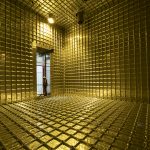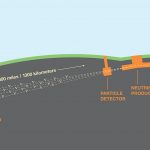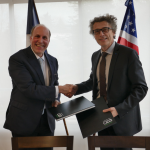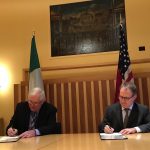For several weeks, a prototype detector for the Fermilab-hosted Deep Underground Neutrino Experiment collected data using beams from CERN’s particle accelerators. The results show a mature technology exceeding all expectations. It’s the culmination of three years of hard work by a global team dedicated to constructing and bringing the new detector online.
Deep Underground Neutrino Experiment
From the University of Rochester’s Campus Times, Jan. 23, 2019: A University of Rochester undergraduate working on the Deep Underground Neutrino Experiment is interested in characterizing neutrinos because of the broad impact the particles may have on the very existence of matter.
From Black Hills Pioneer, Jan. 18, 2019: South Dakota media reports on a public informational meeting that introduced the general contractor/construction manager for the Long-Baseline Neutrino Facility to the community.
For the first time, scientists have demonstrated that low-energy neutrinos can be thoroughly identified with a liquid-argon particle detector. The results, obtained with the ArgoNeuT experiment, are promising for experiments that use liquid argon to catch neutrinos, including the upcoming Deep Underground Neutrino Experiment.
Fermilab has finalized an agreement with construction firm Kiewit-Alberici Joint Venture to start pre-excavation work for the Long-Baseline Neutrino Facility, which will house the enormous particle detectors for the Deep Underground Neutrino Experiment. The South Dakota portion of the facility will be built a mile beneath the surface at the Sanford Underground Research Facility in Lead, South Dakota.
From Gasworld: Jan. 1, 2019: Trade publication Gasworld published a three-page cover story on DUNE, focusing on the experiment’s use of liquid argon. Print edition only.
Agencies in the United States and France have signed statements expressing interest to work together on the development and production of technical components for PIP-II, a major particle accelerator project with substantial international contributions. In addition, the French agencies also plan to collaborate on DUNE, an international flagship science project that will unlock the mysteries of neutrinos.
From Québec Science, Dec. 3, 2018: La mise en service d’immenses détecteurs au Fermilab, aux États-Unis, pourrait prochainement faire la lumière sur des particules aussi bizarres que prometteuses: les neutrinos.
From Kane County Connects, Dec. 4, 2018: Illinois media marvels at the 25-foot-high thermometer built for ProtoDUNE.
The agreement launches a multinational collaboration to build a powerful new accelerator at DOE’s Fermilab complex. Italy and its National Institute of Nuclear Physics will provide major contributions to the construction of the 176-meter-long superconducting particle accelerator that is the centerpiece of the PIP-II project.





